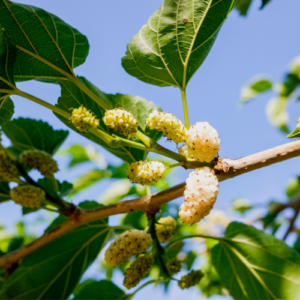THE WHITE MULBERRY TREE
In local dialect “Lu Moru”
Morus alba L.
Moraceae
The white mulberry tree (Morus alba) not only shares many features with the black mulberry tree, but it also has some distinctive characteristics.
🍃 Its leaves are smaller and light green compared to those of the black mulberry tree.
🍇 Its fruits are typically white mulberry, although they can sometimes be darker.

🌍 ORIGINS AND DIFFUSION
📍 The white mulberry tree is native to northern China and Korea.
In the Marche region, particularly in the provinces of Ascoli Piceno and Fermo, the cultivation of white mulberries had great importance for silkworm breeding.
After the end of the Italian silk age, a new use for mulberry trees was discovered. Their leaves made excellent fodder for animals, to the point that it was said, “pe’ ngrassà li manzi ce vo la fava e la fronna de’ lu’ moru” which means “to fatten cattle, you need broad beans and mulberry leaves.”.”

Later, they were also used as ornamental plants, thanks to their elegant habit and golden foliage. Unfortunately, its uncollected fruits would spoil the streets and cars, and gradually, increasingly more fruitless mulberry trees were selected.

Today, they have almost completely disappeared from the market,
and we are among the few who have replanted them in order to preserve these trees, rich in history and delicious fruits. With the white mulberry in particular, we have explored the use of its fruit preserved in wine and vinegar, creating an interesting sweet-and-sour preserve, designed for summer dishes, cold pairings, and salads.
These contents were written and researched by the owners of the SiGi Agricultural Company in collaboration with the students of the Agricultural Technical Institute of Macerata.
If you would like to contribute to expanding the descriptions of these varieties, you can send an e-mail to info@agricolasigi.it
We launched the e-museum of ancient fruits thanks to a social farming project of the Marche region. The translation is by komalingua
This project enabled five young people with cognitive impairments, aged 20 to 25, to work on the farm. They were selected by psychologists and Anffas social workers, supported by the professional educator Il Faro and supervised by UniMc researchers. Coldiretti Marche handled communication and distribution.
This unique and challenging project led to the creation of both a physical and virtual museum of ancient fruits in SiGi’s garden. This is not only a great honor but also a significant commitment that we are willing to continue with everyone’s support. You can contribute to our projects by choosing our products, or you can do so directly here:

